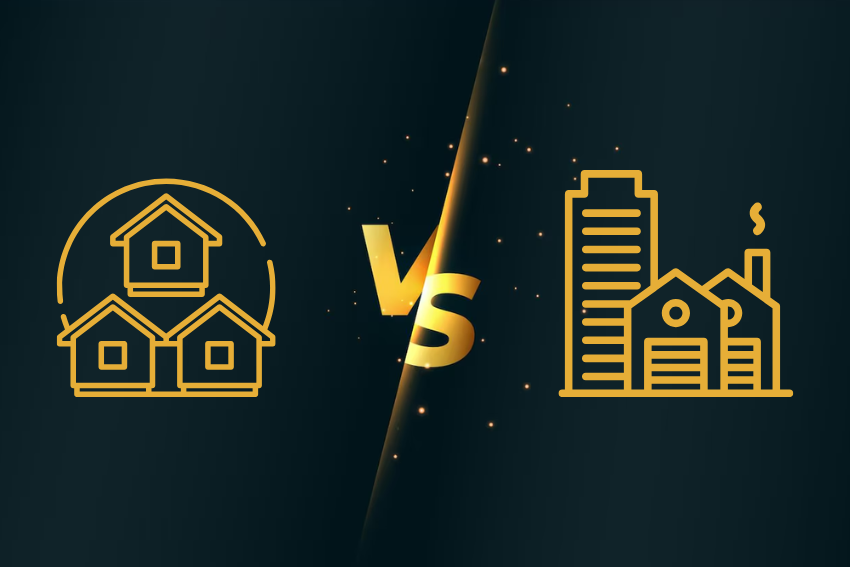Construction is an immense universe of possibilities, always in motion, and teeming with potential but not all construction projects are equal. Underlying this is a gigantic gap between the two categories: residential vs. commercial construction. Both involve building structures for human habitation, yet their applications, materials, code requirements, and management strategies have an immense degree of difference.

Understanding the differences between residential vs. commercial construction is not just helpful, it is imperative. As a project manager, an architect, an investor, or a builder, knowing residential vs. commercial construction will influence your timelines, planning, budgeting, and success.
Residential construction is all about a building where one resides, but comfort, custom, and efficiency are the ultimate concerns. Commercial construction is all about building where one works, trades, and industrially manufactures, where size, safety, and compliance are all the ultimate concerns.
Here, we will explore the key differences between residential vs. commercial construction from materials and design to regulation and expense, so you can make smart, intelligent decisions on your next project.
What is Commercial Construction?
Commercial construction is the structural work of structures that are brought into existence to host businesses or the public. Some examples include office buildings, shopping centers, hotels, restaurants, warehouses, and factories. The focus is on building spaces that facilitate business, productivity, and customer interaction.
Commercial buildings have one of the characteristics of complexity and size. They will usually be multi-story, sophisticated mechanical systems, and have code requirements like the International Building Code (IBC) and the Americans with Disabilities Act (ADA).
Other than dimensions, business structures need more fireproofing, accessibility, and resistance since they hold the public and are subjected to intense usage. Sophisticated materials such as glass partitions, concrete reinforcement, and steel structures are used to provide lasting stability and protection.
Beyond the technicalities, commercial building construction entails tidy planning and cautious coordination of interested stakeholders — developers, investors, architects, engineers, and government officials. The process is longer and in terms of capital to undertake than for residents, but the payout is huge for anyone who sees it through.
What is Residential Construction?
Residential construction, however, is more concerned with producing lived-in space for houses and homes. Duplexes, single-family homes, townhouses, and tiny apartment buildings are types of residential construction. Residential construction is more concerned with energy, comfort, and beauty than with quantity, unlike commercial construction.
These homes typically follow the International Residential Code (IRC) in terms of safety, insulation, electrical, and structural code. Their materials of preference (wood framing, drywall, and brick) are inexpensive but also warm and livable.
A second differentiator is the factor of customization. Owners are mostly directly engaged in the process, selecting plans, finishes, and fixtures. This degree of interaction has flexibility with factors like scope change and custom needs that affect schedules.
This level of interaction has versatility with aspects such as scope change and custom requirements that impact schedules. So, house builders are engineers and artists combined, balancing the needs of beauty, utility, and expense.
Also Read – Best Construction Estimating Software
Residential vs. Commercial Construction: Purpose and Functional Goals
All construction starts with purpose, and the purpose has everything to do with the plan and materials, as well as the management and maintenance.
The task of single-family house construction is simple: build safe, functional, and livable homes. The design emphasizes beauty, efficiency, and living. Open floor spaces, insulation, light, and green systems are what homeowners are interested in that enhance day-to-day livability.
Construction of commercial buildings is not for facilitating the normal course of business, maximizing space, and facilitating maintenance of standards of safety and access. Form is determined by functional requirements, strength, and size and not by personal convenience. For example, an office building will have to incorporate HVAC equipment, fire alarm systems, elevators, and emergency exit stairways — all of which are designed for heavy traffic and public usage.
The variation in intent results in different construction processes. Residential construction involves small groups of labor, flexible design with rapid turnaround.
Residential vs. Commercial Construction: Materials and Construction Methods
Material Choice in Residential Building
Material selection in residential buildings is governed by comfort, cost, and appearance. Homeowners desire materials that will provide a warm, safe, and energy-efficient house, inexpensive and easy to repair.
Advanced Materials in Commercial Construction
Steel provides more tensile strength, enabling multi-level buildings and open floor spaces of large size, not possible with wood. Reinforced concrete provides sufficient load-carrying capacity, and glass facades provide extra aesthetics and natural daylight distribution — a requirement for offices and shopping centers.
Also Read – The Benefits of Using a House Construction Cost Calculator
Residential vs. Commercial Construction: Construction Methods
If you look at construction techniques, the disparity between home and business building is as clear as day.
Home buildings typically employ conventional framing — wood-based construction with simple plumbing, electrical, and insulation integration. The techniques are flexible and best suited for small crews with timetables.
Commercial structures do utilize prefabrication and engineered systems to provide higher accuracy, though.
Residential vs. Commercial Construction: Regulatory Requirements and Compliance
| Aspect | Residential Construction | Commercial Construction |
|---|---|---|
| Regulatory Basis | International Residential Code (IRC) | International Building Code (IBC), ADA, OSHA |
| Primary Focus | Safety and comfort at home | Safety, accessibility, and compliance with the public |
| Code Complexity | Moderate | Extremely High |
| Permit Duration | 1–3 Weeks | 2–6 Months |
| Inspection Frequency | A few major inspections | Several inspections at each stage |
| Enforcement Agencies | Local housing departments | Several (city, fire, OSHA, environmental) |
Residential vs. Commercial Construction: Location Selection and Planning
Considerations in the Selection of Residential Sites
Location is the key to a residential building. Low crime rates, the prestige of an area, and zoning of an area are other factors determining feasibility.
The provision of facilities like electricity, water, sewerage, and internet connectivity is also a critical parameter to consider. Soil testing and drainage surveys in most places also constitute a part of the site analysis to determine structural stability to prevent future issues like cracks in the foundation or flooding.
Investment-wise, location determines building worth as well as resale worth. A home well situated in a desirable area will be sure to appreciate faster, and the selection of the site is quite possibly the most major decision in building residential houses.
Strategic Site Selection for Commercial Projects
Commercial location selection is a more extensive and more reflective decision-making process. Location has a direct impact on the profitability, visibility, and access of the company.
Things to be considered are.
- Traffic Flow: High traffic fetches customers and offers visibility.
- Accessibility: Convenient employee, delivery, and customer access is crucial.
- Zoning Laws: The location must be zoned for commercial or mixed use.
Also Read – What is Construction Takeoff? Process, Benefits & Challenges
Residential vs. Commercial Construction: Construction Timelines
Why Residential Projects Are Quicker
Residential buildings tend to go more quickly with less project scale, uncomplicated design, and fewer regulatory hurdles.
Homebuilders are readily able to accommodate schedule changes to customers or weather-related delays. The smaller scale enables easy access to materials, and something akin to inspections or hookups to utilities to be easily done.
Speed does not mean careless. Accuracy and quality control are still essential. Homebuilders need to walk the tightrope of speed and accuracy to ensure long-term profitability and owner satisfaction.
Planning and Scheduling Commercial Construction
Commercial construction, however, will take two or three years or more. The extended schedule is because the scope is larger, the infrastructure is more sophisticated, and the requirements are more intensive.
Each stage tends to overlap with another, and there must be close scheduling and coordination between teams.
Delays to commercial timetables include:
- Checks and inspections by various agencies.
- Early architectural design.
- Structural engineering and MEP coordination.
- Dependence on supply chains for specialist materials.
Despite this, commercial developers will, in most cases, use high-level project management software, pre-fabrication, and longer working hours to complete within time. Strategic planning and the optimal utilization of resources are required to prevent costly overruns.
A late home may infuriate a household, but a tight commercial complex can cost developers millions. Planning, coordination, and time are therefore key in commercial project management.
Residential vs. Commercial Construction: Financial and Budgeting Considerations
How Financing is Different
Building construction finance structures vary significantly based on the industry.
Financing home building is commonly acquired through mortgages, private savings, or short-term loans from banks. Pay advance or pay by instalment financing is remitted by the homebuyers via an intermediary lender.
Housebuilders who build more than one house or a housing estate have access to construction loans, which must be repaid once the building is finished or sold.
Commercial building finance is bigger in size, riskier, and institutionally investor based. It is supported by government grants, firms, or private equity groups and run on advanced financial plans. The plans enable financing for design, permits, materials, labor, and contingencies.
Budgeting and Cost Management
Budgeting is a crucial element of efficient project delivery and varies vastly for commercial and residential buildings.
House construction is more flexible, and builders and owners can shift expenditures around as the situation allows. Home budgets tend to focus on the inside finishes, energy efficiency, and cosmetics. For example, owners might overspend on upgrades in the kitchen and underspend on exterior finishes.
In a commercial building, budgeting is a purposeful exercise that necessitates exact control of every dollar. Money must be distributed across several disciplines — architecture, engineering, compliance, safety, and operations. Cost overrun can very easily mushroom owing to the size of the project and regulatory requirements.
| Budgeting Factor | Residential Construction | Commercial Construction |
|---|---|---|
| Funding Source | Mortgages, personal savings | Bank loans, investors, and grants |
| Project Cost Range | $200k–$1M (avg) | $2M–$100M+ |
| Budget Flexibility | High (flexible) | Low (strong financial control) |
| Contingency Reserves | 5–10% | 15–25% |
| Primary Focus | Comfort, aesthetics | Strength, flexibility, ROI |
| Financial Risk | Low to Moderate | High |
Residential vs. Commercial Construction: Project Management Styles
Managing Residential Projects
Managing residential buildings is personal, adaptable, and client oriented. Because residents are highly engaged in decision-making, communication channels must remain open and adaptable.
Managing Commercial Projects
Commercial project managers will also have complex stakeholder dynamics to deal with. Contrary to residential buildings, they will be dealing with multiple customers — investors, developers, government agencies, and sometimes the public. Each of them has different priorities, a cost-vs-time-vs-quality balancing act.
Residential vs. Commercial Construction: Equipment and Machinery
Equipment Needs for Residential Construction
Residential construction involves comparatively straightforward equipment for limited application and space use. Equipment commonly used includes skid-steer loaders, excavators, power drills, saws, and concrete mixers. The equipment is cost-saving, multi-functional, and perfectly appropriate for the construction of houses, landscaping, and small-scale excavations.
Construction teams appreciate the mobility and efficiency it offers in residential areas. The equipment’s small size reduces the risk of damage and speeds up foundation, driveway, and framing work.
The utilization of prefabricated parts is also on the rise. Pre-framed parts, trusses, and prefabricated walls conserve heavy equipment use with neater and less complicated construction. It is environmentally friendly as it conserves waste and enhances accuracy.
Machinery Requirements for Commercial Construction
Commercial building, though, requires rugged, durable equipment to lift massive weights and high-rises. Tower cranes, bulldozers, concrete pumps, scaffolding systems, and forklifts are required to lift steel beams, pour large slabs, and move material around large projects.
Increased technology and automation also create commercial construction work. Modern technology includes GPS equipment, robotic vehicles, and artificial intelligence surveillance devices to assist in increasing precision and safety. Commercial contractors typically rent or subcontract instead of owning due to the expense and weight.
This maintains overhead lower with access to current technology.
Equipment selection affects not only speed but also project efficiency and safety directly. Equipment that has been well selected in commercial construction can make it all work, or cost hundreds of thousands of dollars in lost time.
Selecting Between Residential and Commercial Construction
As a builder, investor, or businessperson starting a business, the selection between these two industries can determine your career or line of business.
If you are interested in creativity, customization, and capability, then building houses is your vocation. It provides the satisfaction of building homes where families make a lifetime of memories.
If coordination at large scales, technology merging, and risk management at high scales are your attraction, then commercial building makes more money and offers long-term stability.
Neither is necessarily better in itself, they are simply doing different things and appealing to various levels of ability. The best professionals are people who have experience in both sectors and the adaptability to bring their skills with them accordingly.
More today, corporations operate in both sectors, providing hybrid offerings such as mixed-use development that integrates residential and commercial property. This flexibility provides an opportunity to diversify revenues and adjust to market fluctuations.
Conclusion
Residential buildings are about livability, personalization, and warmth, constructing the homes we live in. Commercial building is about compliance, size, and efficiency, constructing the spaces where economies flourish and communities develop.
Each category presents its own set of challenges — from specs to budget constraints — but also endless possibilities. By honoring their differences in use, material, aesthetic, and process, builders and project managers can do what they do with intention and purpose.
As technology, innovation, and sustainability continue to redefine the sector, the lines between residential and commercial building are blurring. Everything else remains the same, but the commitment to innovation, quality, and safety is what distinguishes both types of construction.
Whether building a foundation for a family’s dream home or designing a skyscraper that dominates a city skyline, the same holds — every great building starts with grasping its function and within that awareness is the real art of building.


